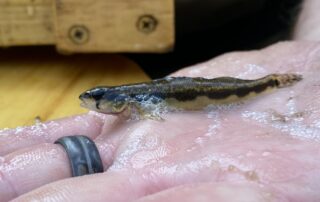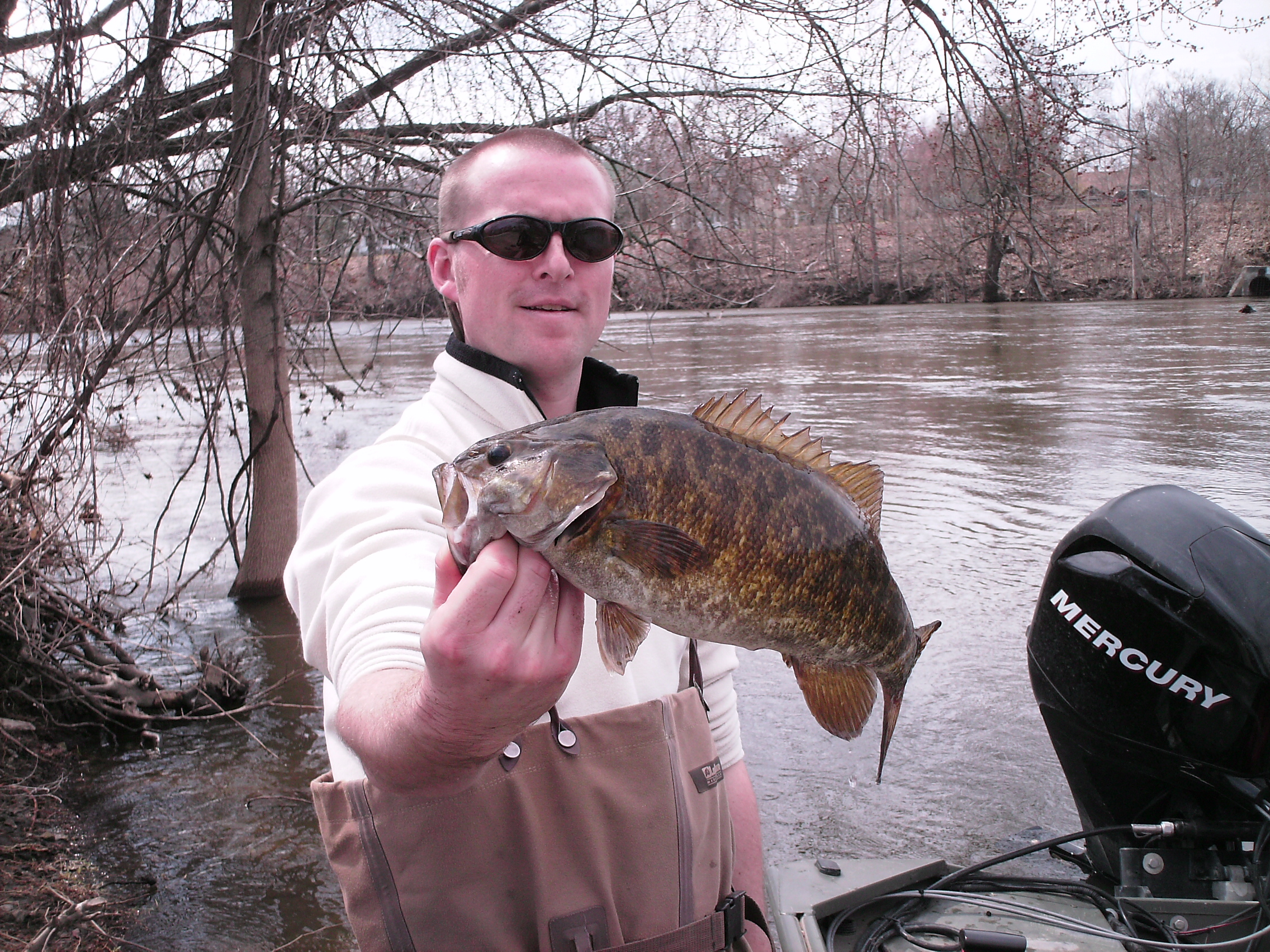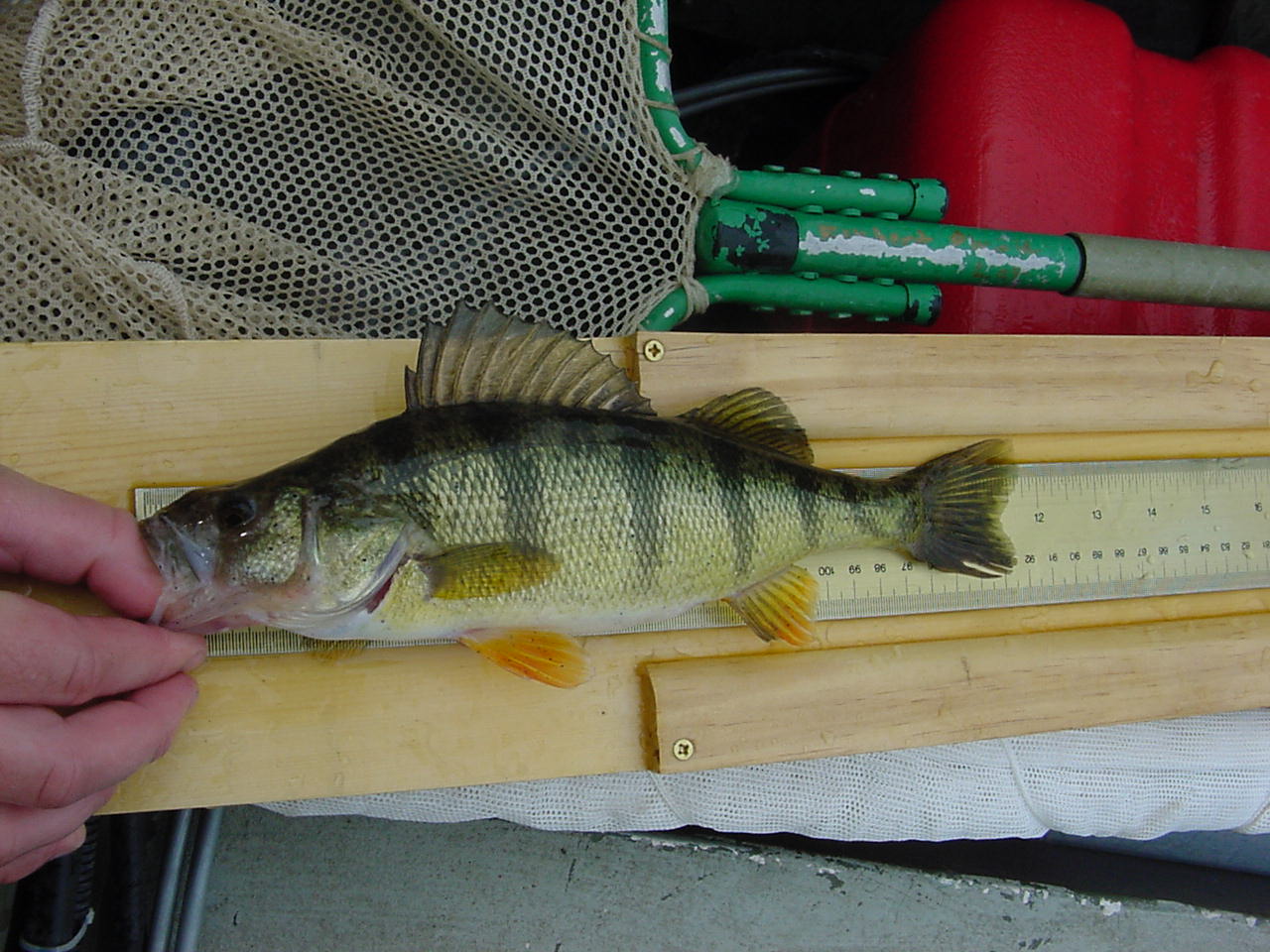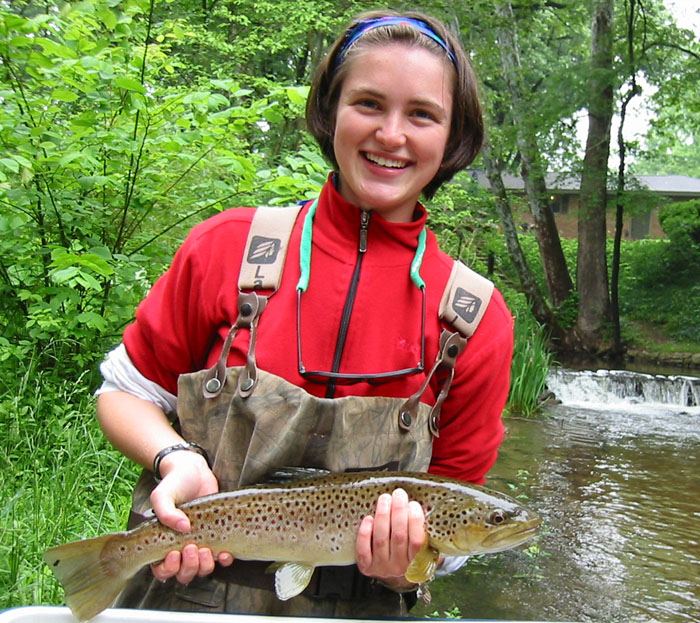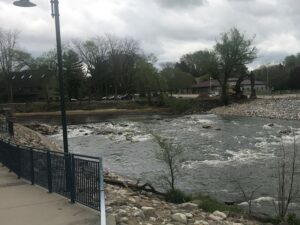Aquatic Biology Program
 Public Works & Utilities
Public Works & Utilities
.
About
To find out more about the program visit: https://arcg.is/1DzeK51
The Aquatics Program is a joint effort between the Cities of Elkhart and South Bend to evaluate the health of the St. Joseph and Elkhart Rivers and their tributaries. The program’s main focus is to evaluate the fish communities of local rivers and streams. However, it also looks at the health of the macroinvertebrate (insects and other small animals) communities, collects water samples, and samples the tissue of certain species to evaluate fish consumption safety. In recent years the program has also done some sampling of aquatic plants, turtles and crayfish in local waterways.
All of the data gathered by the program, biological and chemical, is used in a comprehensive evaluation of the health of our local waterways. Since the inception of the program in 1998, a significant amount of data have been collected on the health of our local rivers and streams.
This program has its own separate webpage – https://arcg.is/1DzeK51
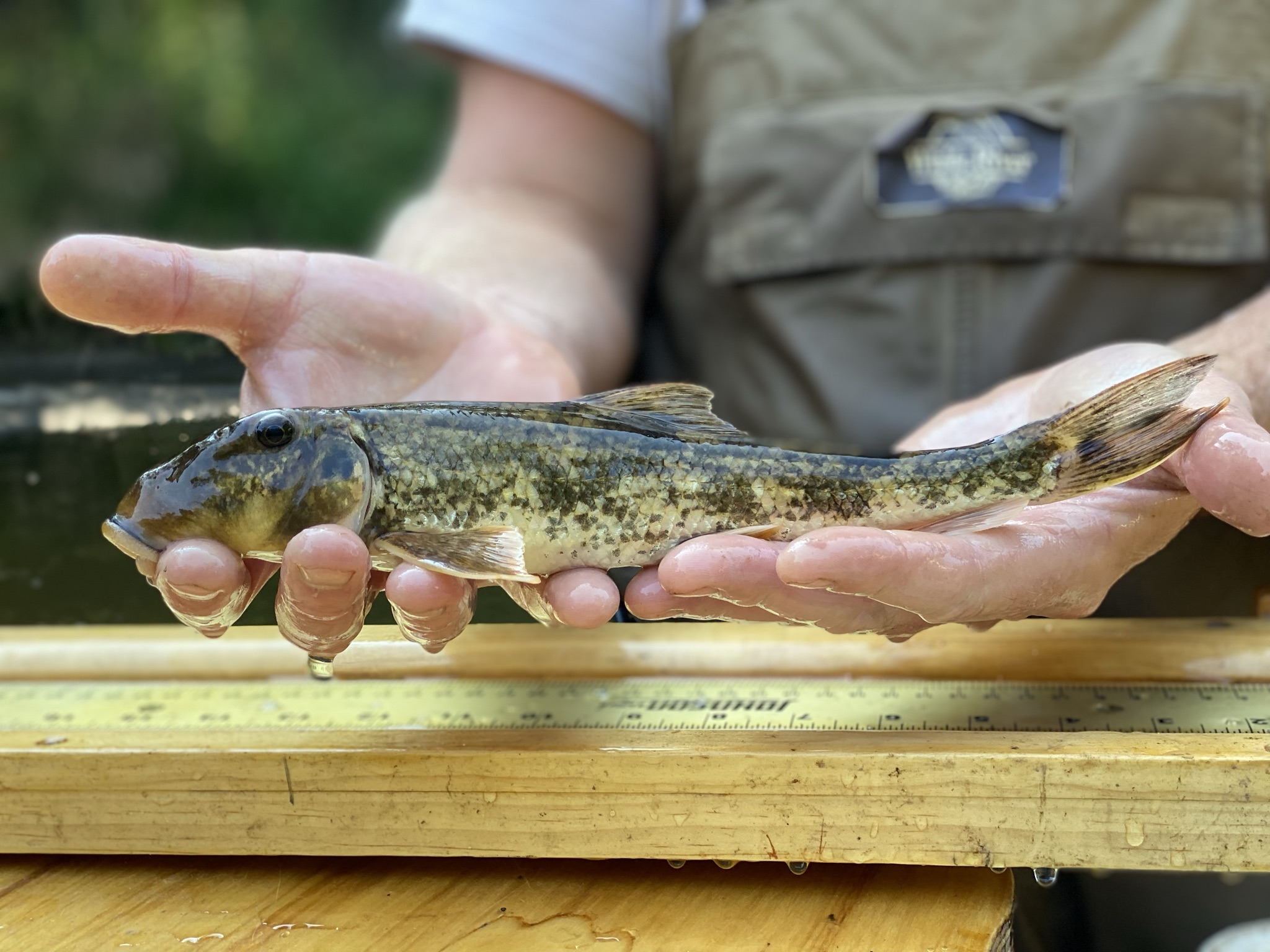
 Welcome.
Welcome.
The Public Works & Utilities Department consists of a variety of different divisions with a common goal of providing vital city services to citizens of Elkhart. These divisions operate and maintain the City’s stormwater conveyance system, drinking water supply and distribution system, wastewater collection system, and wastewater treatment.
Our Mission
- To serve as a reliable provider of City services
- To provide these services at a reasonable cost
- To maintain a customer focus
- To serve as a steward of our natural resources for future generations
- To foster professional excellence
Tory Irwin
City Engineer
Laura Kolo
Utility Services Manager
Tim Reecer
Customer & Executive Services Manager
Joe Foy
Stormwater Utility Manager
574-293-2572
574-293-7658
Public Record Request.
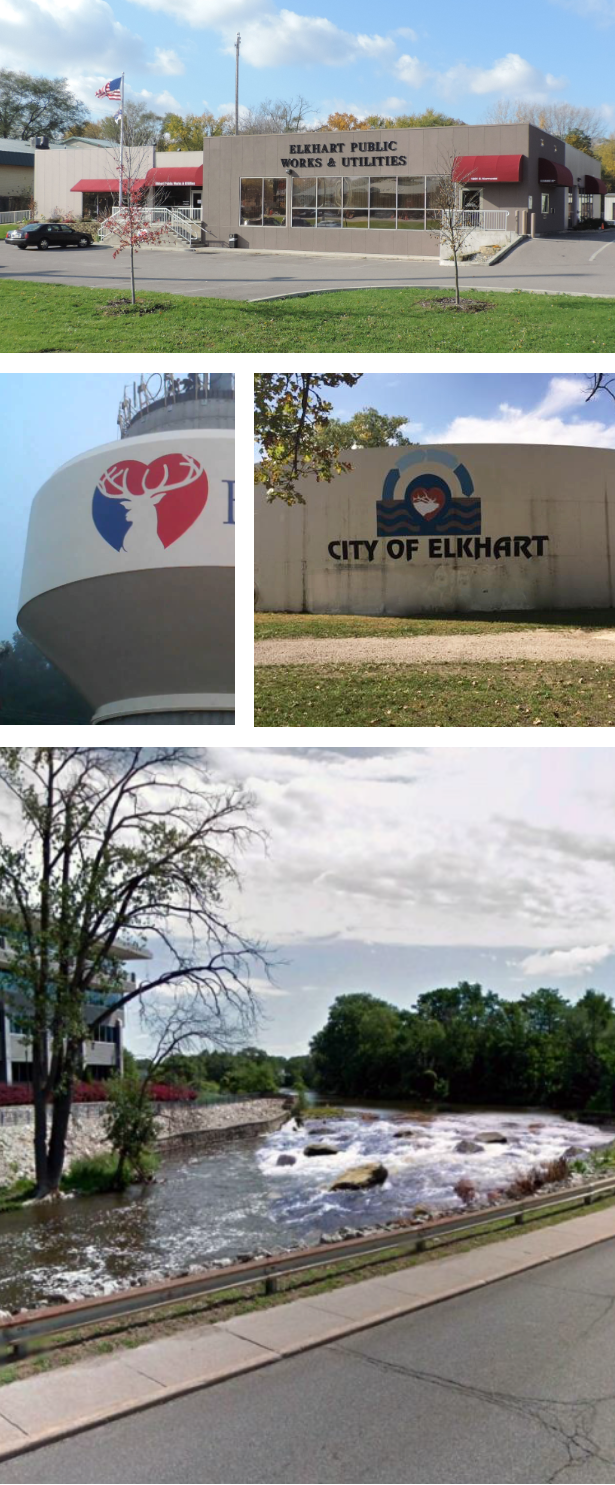
 Online
Online
Bill Pay.
Aquatic
Biology
.
About
The Aquatics Program is a joint effort between the Cities of Elkhart and South Bend to evaluate the health of the St. Joseph and Elkhart Rivers and their tributaries. The program’s main focus is to evaluate the fish communities of local rivers and streams. However, it also looks at the health of the macroinvertebrate (insects and other small animals) communities, collects water samples, and samples the tissue of certain species to evaluate fish consumption safety. All of the data gathered by the program, biological and chemical, is used in a comprehensive evaluation of the health of our local waterways. Since the inception of the program in 1998, a significant amount of data has been collected on the health of our local rivers and streams.
Why We Monitor
The St. Joseph River is the most important natural resource in the communities of South Bend and Elkhart. As our communities developed around the river in the 1800s, we used it as a mode of transportation, a source of energy for industry and electricity, and as a conveyance for getting rid of our waste. Early uses of the river drastically impacted its health, but it has improved significantly. The Elkhart-South Bend Aquatics Program is gauging the health of the river from a long-term perspective.
Annual
Reports
.
The Aquatic Biology generates a report annually of biological monitoring activities.
Reports
2022 Aquatic Monitoring Report
2021 Aquatic Monitoring Report
2020 Aquatic Monitoring Report
2019 Aquatic Monitoring Report
2018 Aquatic Monitoring Report
2017 Aquatic Monitoring Report
2016 Aquatic Monitoring Report
2015 Aquatic Monitoring Report
2014 Aquatic Monitoring Report
2013 Aquatic Monitoring Report
2012 Aquatic Monitoring Report
2011 Aquatic Monitoring Report
2010 Aquatic Monitoring Report
2009 Aquatic Monitoring Report
2008 Aquatic Monitoring Report
2007 Aquatic Monitoring Report
2006 Aquatic Monitoring Report
2005 Aquatic Monitoring Report
2004 Aquatic Monitoring Report
2003 Aquatic Monitoring Report
2002 Aquatic Monitoring Report
2001 Aquatic Monitoring Report
2000 Aquatic Monitoring Report
1999 Aquatic Monitoring Report
1998 Aquatic Monitoring Report
The St. Joseph River – Its Health from a Historic Perspective
.
The St. Joseph River has played a significant role in the history of Elkhart and St. Joseph Counties. While it is a really important ecological resource, it has played a vital role from an infrastructure perspective. From early navigational importance to harnessing its power for mills and electricity, it has it has been instrumental in the evolution of our communities. During the industrial revolution and up until the 1950s, the St. Joe was used a conduit for getting rid of our waste and as a result it was highly polluted and almost void of aquatic life in urban areas. While we still use the river as a vital source for managing our rainwater, our actions have led to a rebirth of the St. Joe.
Check out our video to hear more about the St. Joe’s troubled past and recovery.
Fish of the St. Joseph River Watershed
.
The St. Joseph River Watershed is home to almost 90 species of fish. Many of these species are found in the St. Joseph River itself but some species are “habitat specialists” and only found in certain streams. Below is a list of the various species that have been documented by the Aquatic Biology program. Click the links to find out more about a given species.
Lamprey
Chestnut Lamprey (Ichthyomyzon castaneus)
Silver Lamprey (Ichthyomyzon unicuspis)
American Brook Lamprey (Lampetra appendix)
Northern Brook Lamprey (Ichthyomyzon fossor)
Gar
Spotted Gar (Lepisosteus oculatus)
Longnose Gar (Lepisosteus osseus)
Bowfin
Bowfin (Amia calva)
Herring
Gizzard Shad (Dorosoma cepedianum)
Salmon
Chinook Salmon (Oncorhynchus tshawytscha)
Coho Salmon (Oncorhynchus kisutch)
Brown Trout (salmo trutta)
Rainbow Trout (Oncorhynchus mykiss)
Mudminnow
Central Mudminnow (Umbra limi)
Pike
Grass Pickerel (Esox americanus vermiculatus)
Northern Pike (Esox lucius)
Muskellunge (Esox masquinongy)
Minnows
Common Carp (Cyprinus carpio)
Goldfish (Carassius auratus)
Golden Shiner (Notemigonus crysoleucas)
Horneyhead chub (Nocomis biguttatus)
River chub (Nocomis micropogon)
Creek Chub (Semotilus atromaculatus)
Blacknose Dace (Rhinichthys atratulus)
Longnose Dace (Rhinichthys cataractae)
Rosyface Shiner (Notropis rubellus)
Striped Shiner (Luxilus chrysocephalus)
Common Shiner (Luxilus cornutus)
Spottail Shiner (Notropis hudsonius)
Spotfin Shiner (Cyprinella spiloptera)
Sand shiner (Notropis stramineus)
Mimic Shiner (Notropis volucellus)
Sliverjaw minnow (Notropis buccatus)
Fathead minnow (Pimephales promelas)
Bluntnose minnow (Pimephales notatus)
Central Stoneroller (Campostoma anomalum)
Suckers
Quillback Carpsucker (Carpiodes cyprinus)
Silver Redhorse (Moxostoma anisurum)
Black Redhorse (Moxostoma duquesnei)
Golden Redhorse (Moxostoma erythrurum)
Shorthead redhorse (Moxostoma macrolepidotum)
Greater Redhorse (Moxostoma valenciennesi)
River Redhorse (Moxostoma carinatum)
Northern Hogsucker (Hypentelium nigricans)
White Sucker (Catostomus commersoni)
Spotted Sucker (Minytrema melanops)
Lake Chubsucker (Erimyzon sucetta)
Catfish
Channel Catfish (Ictalurus punctatus)
Yellow Bullhead (Ameiurus natalis)
Brown bullhead (Ameiurus nebulosus)
Black Bullheads (Ameiurus melas)
Stonecat (Noturus flavus)
Tadpole Madtom (Noturus gyrinus)
Flathead Catfish (Plyodictis olivaris)
Pirate Perch
Pirate Perch (Aphredoderus sayanus)
Killifish
Banded Killifish (Fundulus diaphanous)
Starhead Topminnow (Fundulus dispar)
Blackstriped Topminnow (Fundulus notatus)
Silverside
Brook Silverside (Labidesthes sicculus)
Mosquitofish
Mosquitofish (Gambusia Sp.)
Stickleback
Brook Stickleback (Culaea inconstans)
Stickleback
Brook Stickleback (Culaea inconstans)
Sunfish & Bass
White Crappie (Pomoxis annularis)
Black Crappie (Pomoxis nigromaculatus)
Rock Bass (Ambloplites rupestris)
Smallmouth Bass (Micropterus dolomieu)
Largemouth Bass (Micropterus salmoides)
Warmouth (Lepomis gulosus)
Green Sunfish (Lepomis Cyanellus)
Hybrid Sunfish (Lepomis sp.)
Bluegill (Lepomis macrochirus)
Longear Sunfish and Northern Sunfish (Lepomis megalotis and Lepomis peltastes)
Redear Sunfish (Lepomis microlophus)
Pumpkinseed Sunfish (Lepomis gibbosus)
Perch
Walleye (Sander vitreus)
Yellow Perch (Perca flavescens)
Blackside Darter (Percina maculata)
Logperch (Percina caprodes)
Johnny Darter (Etheostoma nigrum)
Greenside darter (Etheostoma blennioides)
Iowa Darter (Etheostoma exile)
Rainbow Darter (Etheostoma caeruleum)
Sculpin
Mottle Sculpin (Cottus bairdi)
Elkhart River Dam Removal
.
The Elkhart River Dam, located in downtown Elkhart, was removed in January of 2020. The Aquatic Biology Program performed several surveys above and below the dam prior to its removal and determined that there was a significant disparity in the number of fish below the dam versus the number of fish above. In the summer of 2020, the Aquatic Biology Program sampled above the dam and documented numerous new species that recolonized the Elkhart River following the removal. The report below details the new species discovered above the dam and other fish community benefits as a result of the project.
Dam Removal Monitoring Report 2022
The St. Joseph River
The Indiana stretch of the St. Joseph River, from Bristol to the downstream side of South Bend, offers excellent fishing opportunities. There are numerous game species that can be caught, from steelhead and salmon that swim out of Lake Michigan, to a prolific smallmouth bass fishery that draws countless bass anglers and tournaments. Other heavily pursued fish include walleye, panfish (bluegill and crappie), channel catfish, and more. While serious anglers continuously fish their hot spots on the St. Joseph River, it also offers a lot of opportunities for those that don’t get to fish often or those that are new to fishing. There are good opportunities for shore fishing (especially below the dams) and numerous boat launches to accommodate several differnt types of boat fishing experiences.
People interested in learning more about fishing opportunities on the St. Joseph River should feel free to contact us at 574-293-2572 to speak with the Aquatic Biology staff.
The Elkhart River
Being a much smaller river than the St. Joe, the Elkhart River offers a slightly different fishery. Small boats and canoe and kayak fishing are popular approaches on the Elkhart, which has a very healthy smallmouth bass population, and an abundance of northern pike and largemouth bass in the backwater areas. Walleye are also stocked in the Elkhart River, which can be found in deeper holes in the summertime or up by the Goshen Dam in the early spring. There are good shorefishing opportunties in the parks in Goshen and further upstream by the Baintertown and Benton Dams.
The Little Elkhart River
The Little Elkhart River is a cool water habitat that supports a strong population of brown trout. Rainbow trout are also stocked in the river by the Indiana DNR every spring, although many of the rainbows are harvested within the first few weeks of being stocked. Bonneyville Mills County Park in Bristol and Riverbend Park in Middlebury provide good shoreline access. There is also a designated catch and release section of the river upstream of Riverbend Park that attracts serious fly fishing anglers from around the area.
Elkhart River Walleye
Walleye in the Elkhart River – YouTube
Muskie in the St. Joe Watershed
Muskie on the St Joe 6 2 17 – YouTube
Steelhead in the St. Joe
Collecting steelhead for samples on the St. Joseph River – YouTube
Smallmouth Bass Tagging Program
Tagged Fish from the St. Joe in Elkhart and South Bend – YouTube
 Is it Safe to Eat Fish From our Local Rivers?
Is it Safe to Eat Fish From our Local Rivers?
It is apparent from talking with local residents that many people don’t have a great understanding of whether or not it is safe to eat locally caught fish. There is a perception among many that fish are completely unsafe to eat out of the rivers, while others claim that it’s just fine to eat any species without concern. The truth lies somewhere in between. It has a lot to do with the species of fish, its size, and where it was caught. A variety of fish species are safe to eat from our local rivers and streams, as long as they are consumed in moderation and as recommended in the State’s Fish Consumption Advisory.
The State of Indiana, through several agencies, monitors fish contaminant information in water bodies across the state of Indiana in an effort to provide guidance on consuming wild fish. The St. Joseph River is included in their fish consumption advisory, with a significant amount of the data provided by the Elkhart-South Bend Aquatics Program. Detailed information on fish consumption in Indiana can be found at the Indiana Department of Health’s website.
Community Outreach and Education
Since 1998, the Aquatic Biology Program has put a lot of emphasis on engaging the Michiana community about the health of our local waterways. Through interactive presentations and demonstrations and meeting local school groups at the river we are able to tell the story of the Joseph River Watershed through the eyes of the fish. If you are interested in an educational program with the Aquatic Biology Program, feel free to contact us at 574-293-2572.
Elkhart-South Bend Aquatic Community Monitoring Program – Outreach Efforts – YouTube
Programs
& Services
.
.
Sign up for service:
As a precautionary measure to slow the spread of the Covid-19 virus, our lobby is currently closed. As a result, all sign-ups will need to be conducted through the drive-thru or via e-mail. Please use the forms below and email your applications to elkhartwaterbilling@coei.org along with a lease or settlement statement and your driver’s license. After receiving the necessary documents, a representative will reach out to you to schedule an appointment to start water services.
At this time, ALL fees and deposits, as required, will be billed upon our return to the office. If you have any questions, please do not hesitate to reach out via email at elkhartwaterbilling@coei.org.
- Utility Information Sheet in English
- Hoja de informacion de utilidad/Utility Information Sheet in Spanish
- Utility Service Application in English
- Aplicacion de servicios publicos/Utility Service Application in Spanish
Pay Your Bill:
There are several convenient ways to pay your water/sewer bill:
- In person at the Billing Office with cash, check or money order, or credit or debit cards
- You may sign up for Auto Debit. The Auto Debit form may be obtained at the Billing Office or online here. Your payment will automatically be deducted from your bank account each month on the bill’s due date.
- The Billing Office has a 24-hour payment drop that accepts checks or money orders located by the drive-up window on the north side of the building. Payments made before 8:00 am will be processed before disconnections for non-payment are worked.
- Online or by phone (1-833-250-4483) with a credit card, debit card, or electronic check. Electronic check option is available online only.
Elkhart Public Utilities is pleased to offer customers two quick and easy ways to make Utility account bill payments by credit card (VISA, MasterCard and Discover), debit card, and e-Check.
You can pay your bill anytime, 24 hours a day 7 days a week, and all payments made after 6 pm will be posted the next business day.
Warning: If incorrect bank information is entered the utility will not receive your payment. This will result in a charge to your account and you may also incur late fees.
Utility Rates and Charges:
Effective July 1, 2022, rates were decreased slightly in compliance with House Enrolled Act 1002 repealing the Utility Receipts Tax. The rate change approval from the Indiana Utility Regulatory Commission can be viewed here. The new Schedule of Rates and Charges is available here.
Aquatic
Biology
.
About
The Aquatics Program is a joint effort between the Cities of Elkhart and South Bend to evaluate the health of the St. Joseph and Elkhart Rivers and their tributaries. The program’s main focus is to evaluate the fish communities of local rivers and streams. However, it also looks at the health of the macroinvertebrate (insects and other small animals) communities, collects water samples, and samples the tissue of certain species to evaluate fish consumption safety. All of the data gathered by the program, biological and chemical, is used in a comprehensive evaluation of the health of our local waterways. Since the inception of the program in 1998, a significant amount of data has been collected on the health of our local rivers and streams.
Reports
2020 Aquatic Monitoring Report
2019 Aquatic Monitoring Report
2018 Aquatic Monitoring Report
2017 Aquatic Monitoring Report
2016 Aquatic Monitoring Report
2015 Aquatic Monitoring Report
Why We Monitor
The St. Joseph River is the most important natural resource in the communities of South Bend and Elkhart. As our communities developed around the river in the 1800s, we used it as a mode of transportation, a source of energy for industry and electricity, and as a conveyance for getting rid of our waste. Early uses of the river drastically impacted its health, but it has improved significantly. The Elkhart-South Bend Aquatics Program is gauging the health of the river from a long-term perspective.
Dam Removal Project
The Elkhart River Dam, located in downtown Elkhart, was removed in January of 2020. The Aquatic Biology Program performed several surveys above and below the dam prior to its removal and determined that there was a significant disparity in the number of fish below the dam versus the number of fish above. In the summer of 2020, the Aquatic Biology Program sampled above the dam and documented numerous new species that recolonized the Elkhart River following the removal. The report below details the new species discovered above the dam and other fish community benefits as a result of the project.
Dam Removal Monitoring Report 2020
Fishing in the St. Joseph River
The Indiana stretch of the St. Joseph River, from Bristol to the downstream side of South Bend, offers excellent fishing opportunities. There are numerous game species that can be caught, from steelhead and salmon that swim out of Lake Michigan, to a prolific smallmouth bass fishery that draws countless bass anglers and tournaments. Other heavily pursued fish include walleye, panfish (bluegill and crappie), channel catfish, and more. While serious anglers continuously fish their hot spots on the St. Joseph River, it also offers a lot of opportunities for those that don’t get to fish often or those that are new to fishing. People interested in learning more about fishing opportunities on the St. Joseph River should feel free to contact us.
Is it Safe to Eat Fish From our Local Rivers?
It is apparent from talking with local residents that many people don’t have a great understanding of whether or not it is safe to eat locally caught fish. There is a perception among many that fish are completely unsafe to eat out of the rivers, while others claim that it’s just fine to eat any species without concern. The truth lies somewhere in between. It has a lot to do with the species of fish, its size, and where it was caught. A variety of fish species are safe to eat from our local rivers and streams, as long as they are consumed in moderation and as recommended in the State’s Fish Consumption Advisory.
The State of Indiana, through several agencies, monitors fish contaminant information in water bodies across the state of Indiana in an effort to provide guidance on consuming wild fish. The St. Joseph River is included in their fish consumption advisory, with a significant amount of the data provided by the Elkhart-South Bend Aquatics Program. Detailed information on fish consumption in Indiana can be found at the Indiana Department of Health’s website.
Americans with
Disabilities Act
.
.
In 1990, the Federal Government enacted the Americans with Disabilities Act (ADA). Title II of the ADA required all public organizations with 50 or more employees to adopt a Transition Plan identifying physical obstacles limiting access to programs, services, and activities by persons with qualified disabilities and bring related deficiencies into compliance with the ADA. The City of Elkhart’s elected officials and staff believe everyone has a right to access public rights-of-way, facilities, and programs. The City of Elkhart is committed to making that happen.
The City of Elkhart completed the multi-step process of writing its Transition Plans in 2012. The Right-of-Way Transition Plan and the Programs, Services, and Facilities Transition Plan are available by clicking on the title. The City will continue to review the Transition Plans as new construction projects in the public right-of-way and any renovations of public facilities are completed.
The City of Elkhart acknowledges its desire and responsibility to comply with the Americans with Disabilities Act of 1990. In order to assist individuals with disabilities who require special accommodations for participation in, or access to, City-sponsored public programs, services, and meetings, a request for accommodation can be made by submitting this form or contacting the ADA Coordinator at (574) 293-2572.
Combined
Sewer Overflow
.
.
Combined Sewer Overflow Long Term Control Plan
The City’s sewer system was founded in the 1800’s, and unfortunately was originally built to accommodate both sanitary waste and storm water runoff within the same pipe network. As a result, the City has a system of combined sewer overflow (CSO) points along the waterways throughout the City limits that discharge combined sanitary/storm water runoff during storm events. The City of Elkhart, along with 108 other communities in Indiana, and approximately 772 communities nationwide, is continuously working to reduce the volume and number of occurrences of these overflows. The City is under a Consent Decree with the Environmental Protection Agency (EPA) and Indiana Department of Environmental Management (IDEM) to spend $155 million by 2029 on projects to reduce the overflows and clean up the City’s waterways. Information about this can be found in the links below.
Combined Sewer Overflow
Public Notices
As required by law, any premittees authorized to discharge a CSO to the Great Lakes Basin shall make available to the public an annual notice describing the CSO discharges from its discharge points that occurred in the previous calendar year. To meet this requirement, the City of Elkhart has compiled several documents and sources of data for the public to access. The required Public Notification and the associated documents are provided below.
CSO Public Notification 2021 Annual Notice
LTCP Status Report January 1 – June 30, 2022
LTCP Status Report July 1 – December 31, 2021
Construction
Projects
.
.
| Current or Anticipated City Project | |
| Completed City Project | |
| Current or Anticipated City Project | |
| Not City Managed Project; either partially City-funded or no funding from City |
The following are current or anticipated construction projects within the City. Please note, not all projects listed are being managed by the City.
2020 Major Engineering Projects
WWTP Expansion
Benham Ave Streetscape
Bristol & Baldwin
River District
John Weaver Parkway
Central Green
2020 Other Engineering Projects
Pine & Poplar Sewer
Albany Sewer & Water
Illinois Sanitary
Davis Sanitary
Stark Sanitary
N. Main St. Water
Cone Street
Jaylan Drive
Sussex Sanitary
Cassopolis Streetscape
Marion St
Sidewalk Projects
Future Engineering Projects
Bristol St Widening
Hively Grade Separation
Lexington Water Main
Benham & McKinley
Cassopolis Wayfinding
Notable Past Projects
NE Water Tower
CSO 4 & 30 Separation
CSO 31 Pump & Storage Facility
CSO 33 Separation
CSO 30 Elimination
CSO 6 & 7 Pump & Storage Facility
CSO 14 Separation
Prairie St Overpass
Drinking
Water
.
.
All of the City of Elkhart’s drinking water is supplied from groundwater. This groundwater comes from several hundred feet below ground. The water is pumped to the surface, treated, and sent to City water customers. Three wellfields, the North Main Street Wellfield, the South Wellfield and the Northwest Wellfield provide the water supply for the City of Elkhart.
In 2020, 2.97 billion gallons of safe drinking water was supplied to Elkhart customers through 346 miles of water mains.
Groundwater comes from rain, snow, sleet, and hail that soaks into the ground. The water moves down into the ground passing between particles of soil, sand, gravel, or rock until it reaches a depth where the ground is filled, or saturated, with water called the saturated zone and the top of this zone is called the water table. The water table may be very near the ground’s surface or it may be hundreds of feet below.
Most groundwater is clean, but groundwater can become polluted, or contaminated. It can become polluted from leaky underground tanks, leaky landfills, or when people apply too much fertilizer or pesticides on their fields or lawns. When pollutants leak, spill, or are dumped on the ground they can move through the soil. Groundwater pollution is generally difficult and expensive to clean up.
It is up to each of us to make sure we have clean and safe water to drink!
Annual Water Quality Report (also known as Consumer Confidence Report)
The City is firmly committed to providing water that meets all regulatory requirements for quality and our citizens’ expectations. The US Environmental Protection Agency requires that public drinking water systems provide information to the community describing efforts to protect groundwater, any regulated substances found in the water and an explanation of potential contaminants. Annual water quality reports are sent out by the first part of June every year, for the previous year, and can also be accessed by clicking on the following link.
Master Plan
Elkhart has developed a Water Master Plan to identify the necessary capital improvements to ensure adequate water supply, storage, treatment and distribution for the next ten years. For more information on the plan please call (574) 293-2572.
Programs
& Services
.
.
The City of Elkhart is committed to proactive stewardship of our natural local environmental resources while positioning the community for long range economic growth and sustainability. Ensuring the quality of this balance requires thoughtful and careful development of our community’s utility and transportation infrastructure which link Elkhart citizens to the community’s environmental assets.
The City of Elkhart’s utility infrastructure assets include:
- Drinking water supply and treatment facilities
- Water distribution mains and wastewater collection sewers
- An Indiana Class IV wastewater treatment plant
- Separate storm water conveyance sewers
- All public roadways, streets and alleys
- Traffic Signals
- Vehicular and pedestrian control signage
In order to position Elkhart positively for long range economic growth and sustainability it is critical that infrastructure needs are adequately planned. To accomplish this mission, the primary function of the Engineering division is to develop and implement the master plans for Elkhart’s utility and transportation infrastructure. These plans, founded in scientific methods using baseline metrics for standards, are used to provide guidance for long-range capital improvement, asset management, and environmental management programming. Essential to the usefulness of the planning programs is the intentional use of all appropriate and available technological tools that enhance data management processes, accuracy in data analysis, and communication of analytical results for public understanding.
Elkhart Plan Room
For information on current and upcoming projects with the City of Elkhart, please visit the Elkhart Plan Room. There current and prospective contractors can download information about upcoming projects for the City.
Standard Specifications for Construction
The City of Elkhart has Standard Specifications for Construction for all projects the City bids, or for anyone performing work within the City right-of-way or on City property. These standards are evaluated annually and updated as necessary. This information is useful to all Engineers and Contractors seeking to do work in the City. Information on the City’s standards, rules and regulations can be found using the link below.
Standard Specifications for Construction 2019
Sewer and Water Insurance Programs
The City’s Utility group maintains the sanitary sewer and water mains throughout the system. Services, the pipe connecting the public main to the building, are owned by the property owner that is being serviced. These pipes can break for various reasons – tree roots, age deterioration, settlement, freeze/thaw, etc. For the vast majority of residential properties, the City operates a sewer and water insurance program to help manage the repair work and financially assist with expensive repairs to the service line. More information on these programs can be found below.
Sewer Insurance Policy – English
Sewer Insurance Policy – Spanish
Sewer Backflow Preventer Programs
The City’s combined sewer system on rare occasions can result in a sewer backup in to basements. The City has a sewer backflow preventer program to install devices on the property owner’s sewer lateral (service line) to help prevent this from happening. More information can be found in the following link.
Laboratory
.
.
- Chief Chemist
- Chemist
- 2 Assistant Chemists
- Water Quality Assurance Specialist
- Aquatic Biologist
- 3 Industrial Waste Specialists
- FOG Inspector
Our Water Quality section works with the Operations, Distribution, and Laboratory staff to ensure the delivery of a reliable and safe water supply. The bacteriological testing of new water mains ensures that outside contamination does not enter the water distribution system. Daily analysis of chlorine and fluoride ensure correct chemical doses for optimal effectiveness without using excess treatment chemicals, therefore saving money for our customers. An extensive monitoring program requires sampling and analysis of drinking water throughout the City. The Public Works staff chooses to go beyond the federally mandated frequencies for sampling and analysis. We believe this is another safeguard to protect our customers against potentially harmful contamination.
The Laboratory staff has won the Indiana Water Pollution Control Association’s Laboratory Excellence Award for the 23rd time in twenty-four years of participation. This recognizes the production of excellent, legally defensible data resulting from an outstanding Quality Assurance program that incorporates specialized training, detailed record-keeping, a safe working environment, and detail-oriented staff.
The Laboratory section analyzes over 4,000 samples annually for multiple parameters. The laboratory’s analysis includes drinking water, wastewater, industrial effluent, groundwater, surface water, swimming pool water, biosolids, and soil samples.
Pretreatment
Program
.
.
City of Elkhart Industrial Pretreatment, Dental Mercury and FOG Programs
Working with local industries and businesses to protect the community and the environment!
Industrial Pretreatment Program:
In an effort to protect our treatment works and the quality of our rivers and streams, the Pretreatment staff permits inspects and monitors over 45 industries. The Pretreatment Program administers regulations to make sure the wastewater generated by industries is treated properly. Many industries must pretreat their wastewater before sending it to the sewer. This helps to protect the wastewater treatment system, our employees, the facilities as well as help to ensure that clean, quality water is discharged. Because of our relationships with local industries and their commitment to protecting the environment, our waterways are cleaner today than in previous decades because business practices have improved.
Important documents for local industries:
- Industrial Wastewater Discharge Permit Application (2020) (.doc)
- Commercial/Industrial User Wastewater Questionnaire (.doc)
- Batch Discharge Announcement (.doc)
- TTO Certification Statement (.doc)
- Report Certification Statement (.doc)
- Industrial User Process Report (.doc)
- Wastewater Utility Use Ordinance – No. 5746 (.pdf)
- Enforcement Response Plan (.pdf)
- Wastewater Utility Rates and Charges Ordinance – No. 5827 (.pdf)
IWEA Presentation: Records Part 2 (.pdf)
Dental Mercury:
The Environmental Protection Agency (EPA) published Effluent Limitations Guidelines and Standards for the Dental Category that took effect on July 14, 2017. This rule applies to all dental offices that place, remove or work on mercury amalgam fillings and discharge to the City of Elkhart wastewater treatment plant. The regulation is codified at 40 CFR Part 441. All dental offices that discharge to the City of Elkhart wastewater treatment plant must fill out a One-Time Compliance Report.
Fats, Oils and Grease (FOG)
Program
.
.
City of Elkhart Fats, Oils and Grease (FOG) Program
The goal of the Fat, Oil and Grease (FOG) program is to help protect the City’s sewer infrastructure from blockages and backups. The program works with local food service establishments, industrial customers and local residents to reduce their contribution of FOG to the City’s sewer system. Keeping FOG out of our sewer network helps reduce the cost of sewer service.
A major component of the FOG Program is the registration of ALL FSE’s connected to the City of Elkhart’s sewer system. Once registered and an inspection completed, FSE’s will receive a FOG Registration Certificate. The FOG Registration Certificate will be valid for 3 years from the date of issuance.
FOG comes from many sources:
- Baked goods
- Butter & margarine
- Cooking oil
- Dairy products
- Foods cooked in deep fryers
- Lard
- Mayonnaise
- Meats
- Pastries
- Salad dressings
- Sauces & gravy
- Shortening
FOG Prevention:
Following tips for homeowners, businesses, organizations and restaurants can help reduce the amount of FOG entering the sewer system and avoid expensive sewer backups, and plumbing emergencies, while helping protect water quality in our community.
Do
- Properly dispose of cooking oil by pouring it into a heat-proof, sealable container and placing the sealed container in the trash.
- Scrape food scraps into the trash, not the sink.
- Wipe pots, pans, and dishes with dry paper towels before rinsing or washing them. Then throw away the paper towels.
- Use a sink strainer to catch food items, then empty the strainer into the trash.
Don’t
- Don’t use a garbage disposal or food grinder. Grinding food up does not remove FOG.
- Don’t pour cooking oil, pan drippings, bacon grease, salad dressings, or sauces down the sink or toilet.
- Don’t use cloth towels or rags to scrape plates or clean greasy or oily dishware. When you wash them, the grease will end up in the sewer.
FOG Registration for Food Service Establishments
A major component of the FOG Program is the registration of ALL FSE’s connected to the City of Elkhart’s sewer system. FSE’s established and open before June 1, 2015 will have 90 days (due August 30, 2015) to submit the FOG Discharge Certificate Registration Application (included in this packet). FOG Discharge Certificate will be valid for 3 years from the date of issuance.
- Below are documents that will help FSEs better understand the FOG Program:
- FOG Summary Sheet
- FOG Registration Certificate Application
- FOG Certificate RENEWAL Application
- Grease Trap & Interceptor Cleaning and Maintenance Report
Trash
& Recycling
.
.
The Public Works and Utilities Department facilitates the collection of garbage and recycling efforts within the City of Elkhart with a contracted service provider, Borden Waste-Away for weekly curbside trash and recycling service to all homes and apartments with 4 units or less. Borden Waste-Away can be reached at 574-293-5001.
A few things to keep in mind:
- Please have your trash and recycling bin out by 6 am on your service day.
- If your collection day falls on a holiday, your waste and your recyclables will be picked up on the following day.
- Recyclable materials include glass bottles and jars, aluminum, tin, and steel cans, paper and cardboard, plastics #1 through #7.
- Cart placement must be within 3 feet of the curb or street side and allow 2 feet of clearance from objects such as parked cars, trees, poles, etc.
Please visit Borden’s website at (provide link) or 574-293-5001 for more information including obtaining a trash or recycling cart, large item pickup, recycling of electronic waste and Styrofoam or additional service needs.
To view a map of the Residential Trash Pick-Up boundaries and service days click View Map
Stormwater
.

Stormwater is water from snow and ice melting, as well as rainwater from storms. When stormwater lands on natural surfaces like forests and grassy areas, most of it soaks into the ground. When it lands on streets, parking lots, and other hard surfaces, it usually runs off to another location. As stormwater flows (or snow melts), it picks up debris, chemicals (such as fertilizers and pesticides), dirt, cigarette butts, and other pollutants. This “contaminated” water then enters a storm sewer system and is eventually discharged to a lake, stream, river, wetland, or pond.
The Environmental Protection Agency (EPA) now considers pollution contained in stormwater runoff to be one of the most significant sources of contamination in our nation’s waterways. Within Elkhart stormwater may run off of driveways, parking lots, construction sites, and streets where it picks up oil, grease, sediments, and many other pollutants that are harmful to the environment. As this stormwater washes down our streets it flows into storm drains and then flows directly into local ponds, creeks, and rivers affecting our ability to use our water bodies for drinking water, fishing and recreational purposes. It also degrades aquatic habitats that are essential for waterfowl, fish and other aquatic organisms.
The City of Elkhart’s Stormwater Utility was created in 2006. This system exists to convey the stormwater that drains off yards, roofs, streets, and parking lots from neighborhoods to local waterways or retention ponds. The Utility must also ensure that Elkhart meets state and federal requirements for improving the quality of stormwater runoff. Because most stormwater receives no treatment before it goes into a stream, lake, or river it is important that we keep as many pollutants as possible out of the stormwater runoff.
For more on how the stormwater fee is calculated, please go here.
For developers wanting more information on how to submit a Stormwater Pollution Prevention Plan, please go here.
For homeowners wanting more information on the rain garden or rain barrel incentives, please go here.
Wastewater
.
.
The Elkhart Wastewater Treatment Plant is located at 1201 South Nappanee Street in Elkhart, Indiana. The plant discharges effluent to the St. Joseph River under the authority of the Indiana Department of Environmental Management through the National Pollutant Discharge Elimination System (NPDES). The plant operates under permit #IN0025674.
The facility utilizes an activated sludge process and is designed to treat an average daily flow of 20 MGD (millions of gallons per day). Preliminary treatment includes automatic bar screens and cyclone grit removal. The primary treatment process includes six rectangular clarifiers, and the secondary treatment process includes five aeration tanks, utilizing a biological nutrient removal process for ammonia and phosphorus. Effluent from the facility is disinfected year-round with ultraviolet light.
Sludge produced as a part of treating the wastewater is processed utilizing anaerobic treatment to break down solids and eliminate pathogens. Biosolids are dewatered using two-meter belt filter presses and are landfilled.
Mercury
In 1995, the Environmental Protection Agency and the eight states bordering the Great Lakes agreed to reduce mercury released into waters. This initiative limited mercury discharges into waterways that feed the Great Lakes to an average of 1.3 nanograms per liter each month (ng/L). That’s about one drop of mercury in the water that the City of Elkhart uses in 8 months! The City of Elkhart has a special variance to discharge 1.6 ng/L while we work to eliminate any possible sources of mercury entering our sewer system.
The 1.3 ng/L standard was developed to ensure continuing wildlife safety, but mercury can also poses a risk to humans. To learn more about mercury, including what you can do to help reduce mercury in the environment, please visit the EPA’s mercury website at epa.gov/mercury.
Public
Outreach
.
.
Mercury – The shimmering liquid metal mercury is one of the basic natural elements that make up the Earth’s composition. Mercury is known as a “heavy metal” because it is very dense. Low levels of mercury can be found throughout the environment–in rocks, plants, animals, water and the air. Once in the air, mercury can fall to the ground with rain and snow, landing on the soil or in various water bodies, causing contamination. Lakes and rivers can also become contaminated when there is a direct discharge of mercury-laden industrial waste or municipal sewage. Once present in these water bodies, mercury accumulates in fish and may ultimately reach the dinner table. Mercury exposure at high levels can harm the brain, heart, kidneys, lungs, and immune system of people of all ages. High levels of methylmercury in the bloodstream of babies developing in the womb and young children may harm their developing nervous systems, affecting their ability to think and learn. For more information visit the EPA’s Mercury webpage at https://www.epa.gov/mercury#consumer
Lead in my Drinking Water – Water is lead-free when it leaves the water treatment plant, but lead can be released when the water comes in contact with pipes and plumbing fixtures that contain lead. Lead levels vary, so it is important to identify and remove any lead plumbing. More information can be found at the following sources – https://www.epa.gov/ground-water-and-drinking-water/basic-information-about-lead-drinking-water#main-content; https://drinktap.org/Water-Info/Whats-in-My-Water/Lead-In-Water.
Wipes – “Disposable” or “flushable” toilet cleaning brushes, wipes, tampons applicators, tampons, etc. may say “flushable” on the label, but they can cause blockages and back-ups in our City sewer line. These blockages and back-ups are costly to the City or property owner. For more information on wipes check out these links:
Minnesota Pollution Control Agency – https://www.pca.state.mn.us/wipes
News story about wipes – https://www.youtube.com/watch?v=Wn6fKAvj5WE
Washington Post Article – https://www.washingtonpost.com/business/2019/05/21/flushable-wipes-are-terrible-plumbing/
FOG Disposal – FOG is short for Fats, Oils, and Grease. FOG comes from many sources such as salad dressing, butter, gravy, meats, pastries and mayonnaise. FOG entering the sewer system can cause blockages that lead to sewer back-ups and increases the cost of sewer service. For more information check out the the “Pretreatment Tab” under the Public Works and Utilities Department.



